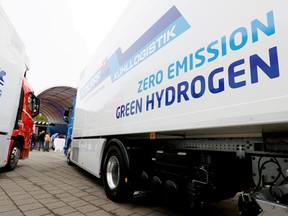
The Financial Post takes a look at some of the biggest issues Canadians have about business and investing in 2022 in our latest Burning Questions series.
This November, Alberta proclaimed that hydrogen “can be the next great energy export that fuels jobs, investment and economic opportunity across our province,” and published a strategic road map to develop this market.
It’s a claim made by others many times in the past. For decades, a rotating cast of venture capitalists, energy executives, environmentalists and scientists have latched onto hydrogen — the most abundant element on earth — as the clean fuel of the future.
But hydrogen has never gained momentum as a fuel, always dragged down by the high cost of production, lack of infrastructure and other obstacles. As Alberta embarks on what is believed to be a multi-year, multibillion effort to produce hydrogen as its next energy export that will require taxpayer and federal support, is there any reason to believe it could succeed where previous newcomers have failed?
“This is kind of the third big push (for hydrogen),” said David Layzell, energy systems architect in Alberta at the Transition Accelerator, a non-profit that advises Canadian governments on a low-carbon economy. “This time feels different — this time is different.”
This time feels different — this time is different
David Layzell
What’s different now, Layzell said, is that many of the world’s largest economies are committed to reaching net zero emissions by 2050, so the demand for fossil fuels is expected to decline in coming years. Meanwhile, technology to support hydrogen as a fuel , which releases no greenhouse gas emissions when burned, has improved.
The strategic road map that Alberta released in November envisions huge growth in global hydrogen consumption, from an estimated 90 million tonnes today, to 700 million tonnes by 2050, a market worth more than $700 billion. That’s about 800 per cent growth from current levels.
Alberta is already one of the largest hydrogen producers in the world, with around 2.4 million tonnes annually, nearly all of which is used by the oil industry to crack bitumen, or turned into ammonia so it can be used as a fertilizer.
For Alberta, producing more hydrogen offers a way to manage the energy transition: the province boasts ample natural gas reserves, which it plans to use to produce hydrogen. That process releases greenhouse gas emissions, but proponents say Alberta’s geology makes it well-suited to carbon dioxide storage, and that, if paired with investment in emissions capture technology, the carbon emissions released to make the product could be dramatically reduced.
Such hydrogen, produced from fossil fuels in combination with carbon capture and storage, is considered ‘blue’ hydrogen, whereas hydrogen produced from renewable energy sources, such as solar or wind power, is considered ‘green.’
Alberta Premier Jason Kenney said while he is “agnostic” about the colour of hydrogen, the industry executives he speaks to believe green hydrogen is a “pipe dream,” and not economic to produce without massive subsidies.
“In the real world, where real private sector money has to be put at risk to produce lower emitting forms of energy, it is going to go to what you are calling blue hydrogen,” Kenney told a group of National and Financial Post journalists last week.

It’s a bold bet: while it is currently cheaper to produce hydrogen using fossil fuels than to use renewable energy, that advantage is expected to reverse over the next decade. As more so-called green hydrogen — produced using wind and solar power — comes online, the price for hydrogen is expected to fall, and hydrogen produced using fossil fuels is not expected to be economic by around 2030.
“We expect to see a steep fall in the cost of green hydrogen in the coming years, making it cheaper than grey hydrogen and blue hydrogen by 2030 in optimal locations,” analysts at Sanford C. Bernstein & Co. wrote in a 253-page report this past summer.
Still, proponents of hydrogen say Alberta has natural advantages, including existing infrastructure.
The big prize in the next ten years, the short term, is to replace diesel
David Sanguinetti
“That whole cost question of whether it’s more economic to produce blue or green hydrogen, that’s an important question,” said David Sanguinetti, a vice president at Foresight Canada, a clean technology accelerator that is supporting hydrogen companies.
Sanguinetti argued that even if blue hydrogen is only economically viable for the next ten or 15 years, that’s long enough to pay down the capital costs of projects that begin now.
He said hydrogen is necessary for large trucks and buses, the ships that carry cargo from Canada to Europe and Asia and for planes — none of which can run purely on batteries at the moment, but contribute significantly to emissions.
Layzell said “the low-hanging fruit” for Alberta is to start by retrofitting diesel buses and trucks so they can run on a blended fuel that contains diesel and hydrogen. This can be done at low cost, he said, and will support the build out of hydrogen production and infrastructure, including fueling stations at select high-traffic corridors.
The next step is fuel-cell trucks that run entirely on hydrogen, he said. Eventually, the larger market would be to begin blending hydrogen into the natural gas used to heat homes, and export it as ammonia — which is far cheaper and safer than shipping it as hydrogen — to markets such as Japan, Korea and Germany that could use it in place of natural gas.
“The big prize in the next ten years, the short term, is to replace diesel,” said Layzell.
Last December, Canada released its federal hydrogen strategy: as part of the pathway to net-zero emissions by 2050, it calls for hydrogen to supply 30 per cent of the country’s energy.
Industry appears to be on board: In Alberta, U.S.-based Air Products and Chemicals Inc. and Suncor Energy Inc. in partnership with utility Atco Ltd. have both announced plans to build hydrogen production facilities.

These projects would likely require significant government investment in carbon capture technology.
Meanwhile, natural gas companies also are planning on capitalizing demand for hydrogen, too.
Bill Yardley, president of gas transmission and midstream for Enbridge Inc., told investors earlier this month hydrogen was the “logical” next transition for his industry. In September, the company said it is signed a memorandum of understanding with Royal Dutch Shell Plc. to jointly develop low-carbon technologies, including potential green and blue hydrogen production.
“…Simply put natural gas is the cornerstone of the next several decades of the global energy story,” he said.
So far, in Alberta, the first step that Layzell envisions of transitioning thousands of long-haul trucks that move between Edmonton and Calgary and use hydrogen as fuel, remains years away.
He estimated that 75 per cent of oil produced in western Canada is used as transportation fuel. As automakers to sell more zero-emission vehicles, Layzell noted demand for oil is going to decline and prices will fluctuate wildly as supply adjusts.
That will be rough for Alberta’s economy but could also affect the market for hydrogen — as competing fuel sources grow cheaper, and more competitive.
“It’s going to be a rough ride,” he said.
• Email: [email protected] | Twitter: GabeFriedz
_____________________________________________________________
If you liked this story, sign up for more in the FP Energy newsletter.
______________________________________________________________
You can read more of the news on source
